|
|
Car Seat Types and Styles
|
INFANT SEAT
|
Rear-facing only. Birth weight or 4-5 lbs to 20 or 22lbs. All seats
manufactured after September 1, 2002 must be equipped with LATCH anchors. |

Graco SnugRide DX5 |
Infant seats come in several styles. Some have a base that you buckle into the
car. Then it's simply a matter of snapping the seat into the base. Others are
"base-less" and simply buckle into the car (as shown in the picture).
Most all infant seats with bases work without the base. There is a choice of a
three-point harness or a five-point. The five-point harness may do a better job
of keeping a small infant in place, but both types offer similar crash
protection. NEVER place a rear-facing seat in the front seat of any car
equipped with a passenger-side airbag - the airbag could deploy and cause
serious injury or death. |
|
FIVE-POINT CONVERTIBLE
|
Rear-facing birth to 22-35 lbs. Forward
facing 20-22lbs to 40-65 lbs. All seats manufactured after September 1, 1999 must be
equipped with a forward facing tether. All seats manufactured after September
1, 2002 must be equipped with LATCH. |
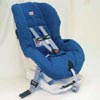
Britax Roundabout |
Five Point convertible car seats are generally
considered to be the best protection and are
recommended by experts over car seats with overhead
shields or t-shields. Convertible seats are used
both rear and forward-facing. Choose a seat with a
higher (30-35 lbs) rear-facing limit (experts
recommend that babies remain rear-facing for at
least 1 year AND 20 lbs, and as long after that as
they fit in a rear-facing seat). |
|
OVERHEAD SHIELD CONVERTIBLE
|
Rear-Facing birth to 22-35 lbs. Forward
facing 20lbs to 40 lbs. All seats manufactured after September 1, 1999 must be
equipped with a forward-facing tether. All seats manufactured after September
1, 2002 must be equipped with LATCH. |

Overhead Shield Graco ComfortSport |
Child Restraints with overhead shield have harness
straps for the shoulders, a crotch strap, and a
large plastic "shield" as the lap restraint. This
type of seat is not recommended for newborns or
small babies, as their head will sit too close to
the shield and could strike it in a crash. Also not
recommended for children with eyeglasses. |
|
T-SHIELD CONVERTIBLE
|
Rear-Facing birth to 22 lbs. Forward
facing 20lbs to 40 lbs. All seats manufactured after September 1, 1999 must be
equipped with a forward-facing tether. All seats manufactured after September
1, 2002 must be equipped with LATCH.
|

Century
2000
|
T-Shields have harness straps attached to a molded rubber shield, shaped like a
"t". These seats are not recommended for babies or small children, as
the shield may be too close to their neck. For an older child, it may be an
option, especially if the adult buckling them in has hand difficulties. The
only seat available in this style is the Century 2000STE. Drawbacks to this
seat include a low 22 lbs rear-facing weight limit, and the seat is buckled in
over the child's legs, making installation difficult. There are no t-shield
seats currently being made. |
|
HIGHER WEIGHT FORWARD-FACING RESTRAINT
|
Forward facing, from 20-30 lbs to 60-80 lbs.
|
|
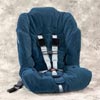
Britax Husky
|
These types of restraint allow children to remain harnessed (or restrained)
past 40 lbs. There are two situations that would necessitate the use of such a
seat.
First, a child who is too young or immature to sit properly in a belt
positioning booster, but is over 40 lbs. Second, any child over 40 lbs who must
ride in a vehicle with only lap belts.
Complete list of higher
weight restraints. |
|
COMBINATION SEAT
|
Forward-Facing only. Use with internal harness from 20-30 lbs to 40-50 lbs. Use
as a belt positioning booster from 30- 40 lbs to 60-100 lbs. Best used with
children age 3 and older, as sides do not have much support for sleeping. |

Graco Platinum Cargo |
A combination seat is a good choice when a child
outgrows a traditional convertible seat. The seat
has an internal harness that is used to 40 lbs. The
harness slots in combination seats are traditionally
higher than those in convertible seats. At 40 or 50
lbs (check your manual) the harness is removed and
the shell is used (along with clips on the sides) to
properly position a lap/shoulder belt. When using
the combination booster as a belt-positioning
booster, it must be used with a lap/shoulder belt,
never just a lap belt. When used with the harness,
it can be installed using only a lap belt.
|
|
BELT POSITIONING HIGH BACK BOOSTER
|
Forward-facing only. Does not have a harness. Used to properly position a
lap/shoulder belt across the hips/chest of a child from 33-40 to 60-100 lbs.
High back models provide head/neck support in vehicles without headrests or
with low seat-backs.
|
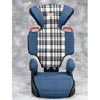
Britax StarRiser/Comfy
|
A belt-positioning booster aids in properly
positioning a lap/shoulder belt across the strong
parts of a young child's body. Many children do not
fit into regular seat belts until they reach 80 lbs,
9 years of age, or 58 inches. The belt-positioning
booster has guides across the bottom to keep the lap
belt off the stomach and clips on the sides to
thread the shoulder belt through so that it lays
properly across the chest/collarbone. Must be used
with a lap/shoulder belt.
|
|
BELT POSITIONING BACKLESS BOOSTER
|
Forward-facing only. Does not have a harness. Used to properly position a
lap/shoulder belt across the hips/chest of a child from 33-40 to 60-100 lbs.
Low back models must be used in vehicles with high seat backs and head support.
|
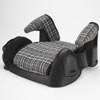
Cosco High Rise |
A low-back belt-positioning booster aids in properly positioning the
lap/shoulder belt across the strong parts of a young child's body. This
belt-positioning booster has guides to position the lap belt across the strong
bones of the hips, and a clip that locks onto the shoulder belt to pull it into
the correct position over the child's chest and collarbone. This kind of
booster has no head or neck support and must be used in a vehicle that has high
seat backs and/or headrests. Must be used with a lap/shoulder belt.
|
|
SHIELD BOOSTER
|
Forward-facing only. Does not have a harness. Should only be used WITHOUT the
shield to properly position a lap/shoulder belt. (Manufacturers instructions
allow child to use with shield from 30-40 lbs, without from 40-60 lbs)
|
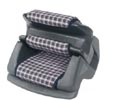
Cosco Grand Explorer
|
Shield boosters were originally the only boosters available for use after a
child outgrew a convertible car seat. However, advances in child passenger
safety and car design have made the shield part of the seat obsolete.
Safety experts recommend that the shield
booster only be used without the shield from 40-60
lbs to properly position a lap/shoulder belt.
Children under 40 lbs should remain in a harnessed
seat (either convertible or combination booster).
There are no shield boosters currently being
manufactured.
|
|





